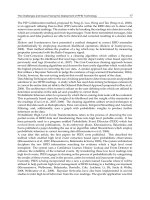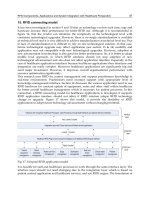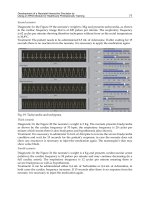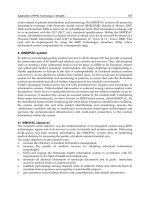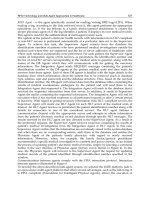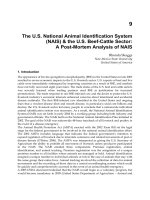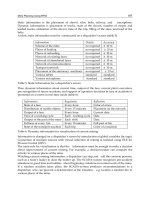Deploying RFID Challenges Solutions and Open Issues Part 1 pot
Bạn đang xem bản rút gọn của tài liệu. Xem và tải ngay bản đầy đủ của tài liệu tại đây (1.01 MB, 30 trang )
DEPLOYINGRFID–
CHALLENGES,SOLUTIONS,
ANDOPENISSUES
EditedbyCristinaTurcu
Deploying RFID – Challenges, Solutions, and Open Issues
Edited by Cristina Turcu
Published by InTech
Janeza Trdine 9, 51000 Rijeka, Croatia
Copyright © 2011 InTech
All chapters are Open Access articles distributed under the Creative Commons
Non Commercial Share Alike Attribution 3.0 license, which permits to copy,
distribute, transmit, and adapt the work in any medium, so long as the original
work is properly cited. After this work has been published by InTech, authors
have the right to republish it, in whole or part, in any publication of which they
are the author, and to make other personal use of the work. Any republication,
referencing or personal use of the work must explicitly identify the original source.
Statements and opinions expressed in the chapters are these of the individual contributors
and not necessarily those of the editors or publisher. No responsibility is accepted
for the accuracy of information contained in the published articles. The publisher
assumes no responsibility for any damage or injury to persons or property arising out
of the use of any materials, instructions, methods or ideas contained in the book.
Publishing Process Manager Davor Vidic
Technical Editor Teodora Smiljanic
Cover Designer Martina Sirotic
Image Copyright Albert Lozano, 2010. Used under license from Shutterstock.com
First published August, 2011
Printed in Croatia
A free online edition of this book is available at www.intechopen.com
Additional hard copies can be obtained from
Deploying RFID – Challenges, Solutions, and Open Issues, Edited by Cristina Turcu
p. cm.
ISBN 978-953-307-380-4
free online editions of InTech
Books and Journals can be found at
www.intechopen.com
Contents
Preface IX
Chapter 1 The Challenges and Issues Facing the
Deployment of RFID Technology 1
Peter Darcy, Prapassara Pupunwiwat and Bela Stantic
Chapter 2 RFID Components, Applications and System
Integration with Healthcare Perspective 27
Kamran Ahsan
Chapter 3 Development of a Neonatal Interactive
Simulator by Using an RFID Module
for Healthcare Professionals Training 51
Loreana Arrighi, Jenny Cifuentes, Daniel Fonseca,
Luis Méndez, Flavio Prieto and Jhon J. Ramírez
Chapter 4 RFID Technology in Preparation and
Administration of Cytostatic Infusions 83
Šárka Kozáková and Roman Goněc
Chapter 5 Application of RFID Technology in eHealth 103
Cristina Turcu, Tudor Cerlinca,
Marius Cerlinca and Remus Prodan
Chapter 6 RFID Technology and Multi-Agent
Approaches in Healthcare 127
Felicia Gîză, Cristina Turcu and Cornel Turcu
Chapter 7 Farm Operation Monitoring System with
Wearable Sensor Devices Including RFID 141
Tokihiro Fukatsu and Teruaki Nanseki
Chapter 8 The Application of RFID in Automatic
Feeding Machine for Single Daily Cow 159
Zhijiang Ni, Zhenjiang Gao and Hai Lin
VI Contents
Chapter 9 The U.S. National Animal Identification System
(NAIS) & the U.S. Beef-Cattle Sector:
A Post-Mortem Analysis of NAIS 167
Rhonda Skaggs
Chapter 10 Mine Planning Using RFID 179
Vladimir Konyukh
Chapter 11 The Applicability of RFID for Indoor Localization 203
Apostolia Papapostolou and Hakima Chaouchi
Chapter 12 Use of Active RFID and Environment-Embedded
Sensors for Indoor Object Location Estimation 219
Hiroaki Fukada, Taketoshi Mori, Hiroshi Noguchi
and Tomomasa Sato
Chapter 13 RFID Sensor Modeling by Using an
Autonomous Mobile Robot 237
Grazia Cicirelli, Annalisa Milella and Donato Di Paola
Chapter 14 Location of Intelligent Carts Using RFID 249
Yasushi Kambayashi and Munehiro Takimoto
Chapter 15 Services, Use Cases and Future Challenges for
Near Field Communication: the StoLPaN Project 265
Carlo Maria Medaglia, Alice Moroni, Valentina Volpi,
Ugo Biader
Ceipidor, András Vilmos
and Balázs Benyó
Chapter 16 RFID Applications in Cyber-Physical System 291
Nan Wu and Xiangdong Li
Chapter 17 SAW Transponder – RFID for Extreme Conditions 303
Alfred Binder, Gudrun Bruckner and René Fachberger
Chapter 18 Internetworking Objects with RFID 319
Rune Hylsberg Jacobsen, Qi Zhang and
Thomas Skjødebjerg Toftegaard
Chapter 19 Applying RFID Technology to Improve User
Interaction in Novel Environments 335
Elena de la Guía, María D. Lozano
and Víctor M.R. Penichet
Chapter 20 Building Blocks of the Internet of Things:
State of the Art and Beyond 351
Alexandru Serbanati, Carlo Maria Medaglia
and Ugo Biader Ceipidor
Contents VII
Chapter 21 RFID Security and Privacy 367
Michel Arnaud
Chapter 22 The Ethics of RFID Technology 377
Joël Schlatter and Fouad Chiadmi
Preface
Radio frequency identification (RFID) is a technology that is rapidly gaining
popularity due to its several benefits in a wide area of applications like inventory
tracking, supply chain management, automated manufacturing, healthcare, etc. The
benefits of implementing RFID technologies can be seen in terms of efficiency
(increasedspeedinproduction,reduced sh
rinkage,lowererrorrates, improved asset
tracking etc.) or effectiveness (services that companies provide to the customers).
Despite these numerous benefits, the technology has limited widespread
implementation, due to the insufficient robustness and reliability of the RFID
technology, cheaper alternatives to RFID (bar‐codes), the costs‐benefits balance of
RFIDimplementationandtheabsenceofc
ommonstandardsandinteroperability.
Intheseconditions,itistheresearchers’goaltocontributetotheimprovementofthis
technologyandtheprovidingofnewandvaluablesolutionstotheindustrypersonnel.
ThebookincludesinterestingresearchstudiesfromexperiencedscientistsintheRFID
domain.
Inchapter1,theauthorspre
senttheimportanceofRFIDandtheshortcomingsofthe
currentapproachesdesignedtocorrectsomeissuesamongtheintegrationofsystems
includingsecurity,privacy,anddataabnormalities.Theyalsorecommendsolutionsto
theseissues.
Chapter2dealswiththestudyoftheRFIDcomponentssuchasantennaandreader.It
alsod
iscussestheRFIDactiveandpassivetags,andcomparesthesetags,considering
both advantages and disadvantages of RFID system. RFID applications are explored
and a technical model is analyzed. The chapter also considers the healthcare
perspectivesandRFIDusewithinhealthcaresettings.Thisstudyoutlinesamodelfor
connected RFID applications, which provides quick support for various healthcare
functionsandenhancesflexibilityfordifferentsystems’componentsintegration.
Chapter 3outlines the experienceand achievements attained in a projectcarried out
by the National University of Colombia. This project was intended to design and
implement RFID‐based tool
s for trainingstudents in medical and nursingtechniques
appliedonneonatalpatients.
X Preface
Theauthorsofchapter4 proposeanRFID‐basedsolutiontoreducethehumanfactor
inthepreparationandadministrationofcytostaticinfusions.
In chapter 5 the authors propose an RFID‐based system that integrates RFID and
multi‐agent technologies in health care in order to make patient emergency care as
efficient and risk‐free as pos
sible, by providing doctors with as much information
about a patient and as quickly as possible. Also they describe a general purpose
architectureanddatamodelthatisdesignedforbothcollectingambulatorydatafrom
variousexistingdevicesandsystems,andstoringclinicallysignificantinformationin
ordertobeacces
sedbytheemergencycarephysician.
Inchapter6theauthorsproposeanRFID‐basedmulti‐agentsystem,thatfacilitatesthe
integrationofdatafromheterogeneoussourcesinordertoachieveacompletepatient
electronicmedicalrecord.Theadoptionofthissystemdoesnotrequiremajorchanges
intermsofthesoftwareresou
rcesexistinginthemedicalunits.
Inchapter7theauthorsproposeafarm operation monitoring systemusingwearable
sensordeviceswithRFIDreadersandvarioussensingdevicessuchasmotionsensors,
cameras,andaGPS.Thissystemrecognizesdetailedfarmingoperationsautomatically
invarioussituationsby analyzingthedatafromsensorsanddetectedRFIDtags.The
tagsandsenso
rsareattachedtorelevantobjectssuchas farmingmaterials,machinery,
facilities,andsoon.Inthischapter,theauthors,basedontheirresearch,describethe
concept and features ofthissystem and theresultsofseveral experiments condu
cted
ona prototype system. The majorapplications and extensionsof the current systems
arealsooutlined.
In chapter 8, the authors introduce the application of RFID in day‐to day activity in
cow industry, regarding the use of RFID technology in automatic cow feeding
machine.
Chapter9focusesonthecow‐calfsector
,withanoverviewofU.S.agricultureandthe
beef‐cattlesector.Finally,theauthorpresentswhatcanbecalled“theNationalAnimal
IdentificationSystem(NAIS)Pushback”.
In chapter 10 the author presents the new potential of RFID‐applications in mine
planning.AnRFID‐based systemcanbeused to visualizetheplacement of machines
inside roadways; to monitor miners with personal transponders; to prevent non‐
permitted control of machines; to prioritize the control of machines; to evaluate the
productivity of both machines and mining areas; to evaluate fuel consumption and
machine resources, etc. After being gathered, this inform
ation is used for the mine
management.
In chapter 11, the authors investigate the applicability of the RFID technology in
location sensing, the main design, and environmental factors that should be
consideredbeforedevelopinganRFID‐basedlocalizationscheme.Theauthorspresent
a scenario according to whichthe location of m
ultiplereader‐enabled terminals need
Preface XI
tobeestimatedbased ontheinformationretrievedfromlowcostpassivetags,which
aredeployedinaparticulararea.Also,theauthorsproposeamathematicalmodelfor
takingintoaccountallimplicatingfactorswhichaffecttheaccuracyperformanceofthe
system, like types of collisions among its components, interference ofmater
ials, and
temporalenvironmentalchanges.
Chapter12analyzesanindoorobjectlocalizingmethodbyusingactiveRFIDtagsand
simpleswitchsensorsembeddedintheenvironment.Theauthorsfocusintheirwork
onobject’sʺlocationʺintheenvironment(e.g.Table,Bed,Sofa,etc.)insteadofobject’s
3‐dimensional position, the only object location allowing the achievement of their
application
.
In chapter 13, an approach for developing an RFID sensor model is presented. The
authors examine recent progresses in fuzzy logic‐based RFID sensor modeling using
an autonomous robot. Constructing a reliable sensor model is very important for
successive applications such as tag lo
calization, robot localization, just to mention a
few.
Chapter 14deals with optimizingdistributed robotic control systems, considering as
example an intelligent cart system designed to be used in common airports. The
presented framework employs an RFID‐based localization algorithm and control
methodsusingmobilesoftwareagents.
In chapter 15 the authors present theservi
ces, use cases and the future challenges of
Near Field Communication, which is the most customer‐oriented one among RFID
technologies.
In chapter 16 the authors study a cyber‐physical system based on RFID technology.
They compare the proposed RFID system with atraditional wireless sensor network
sy
stem and discuss the applicability of the firstone. Finally, the authors present the
design, methodology, and development of an active RFID‐based relative positioning
system,alsoshowingtheexperimentalresults.
Chapter 17 gives an overview of SAW‐based RFID transponders made for extreme
conditionsliketemperatures up to 400°Corc
ryogenic temperatures down to –196°C.
TheauthorsgiveanexplanatoryoutlineofSAWtransponderfunctionprinciplesand
system performance, and also some applicationexamples from steel andautomotive
industries.
The chapter 18 discusses the RFID/WSN technology from a networking perspective.
TheauthorsoutlinethedevelopmentneededtointegrateRFIDsy
stemswithInternet
of Things and present the evolution from today’s connection of objects to the future
networkingofobjects.
Chapter19dealswiththeapplicationofRFIDtechnologytoimproveuserinteraction
innovelenvironments.Theauthorsdescribethedevelopmentandimplementationof
XII Preface
three different use cases, actually implementing the concept of context‐awareness,
locationawareness,andInternetofThings.
Chapter 20 provides a historical and conceptual introduction to the IoT topic. The
work also outlines key aspects intheprocess of moving fromthecurrent state of the
art of IoT, where objects have dig
ital identities, towards a network of objectshaving
digital personalities and being able to interact with each other and with the
environment.Finally,aselectionofthepossibleimpactsoftheIoTisanalyzed.
Chapter21addressissuesoftheprotectingprivacy ofRFIDtagcarriersina“privacy
by desig
n” model, which is described on four different levels: legal aspects, policy
services,technicalspecificationsandsecurityservices.
The final chapter of this book goes beyond identification matters and addresses
aspects referring to the ethics of RFID technology. The author focuses on the ethical
approachthatmustbeconcernedwiththesubjec
tificationofpeoplethroughtheuseof
thetechnology.
Leadingtoconsiderableoperationalandstrategicbenefits,RFIDtechnologycontinues
tobringnewlevelsofintelligenceandinformation,strengtheningtheexperienceofall
participants in this research domain, and serving as a valuable authentication
technology. We hope this bookwillbeus
eful for engineers, researchers and industry
personnel, and provide them with some new ideas to address current and future
issuestheymightbefacing.
CristinaTURCU
StefancelMareUniversityofSuceava
Romania
0
The Challenges and Issues Facing the
Deployment of RFID Technology
Peter Darcy, Prapassara Pupunwiwat and Bela Stantic
Institute of Integrated and Intelligent Systems, Griffith University
Australia
1. Introduction
Radio Frequency Identification refers to wireless technology that uses radio waves to
automatically identify items within certain proximity. This process involves tagging items
with a transmitter which will emit bursts of information including, but not limited to, the
identification of the tag. There are three main varieties of tags: Active, Semi-active and
Passive. Active tags rely solely on a battery for its power source resulting in the maximum
integrity rate and reading range but, also, a limited lifespan and higher cost. Semi-Active
tags use batteries to extend the range of the tag only resulting in a higher reading rate than
passive tags, a longer lifespan than the active tags, but also higher cost. The passive tag uses
the electromagnetic pulse from readers as a power source to transmit its identifier. Due to its
lack of a battery, passive tags are the most cost effective and theoretically have an unlimited
lifespan. However, due to their lack of the power source, passive tags also have a limited range
and produce the largest amount of data anomalies. The RFID Reader is used to interrogate
the zone to discover tags within proximity of the reader range. If a tag is discovered, its
identification along with the reader’s ID and the timestamp of the observation are recorded.
This information is then passed through the Middleware where initial filtration is done to
avoid data anomalies being recorded. Finally, the information will then be stored within a
database ready to be queried for future analysis.
Due to the benefits of the technology, RFID is currently employed in various commercial
sectors to provide automated assistance for mundane tasks. There are hospitals which have
employed tagged bracelets to ensure maximum care is given to surgical patients. At various
airports around the world, RFID is being utilised to track passengers’ bags to ensure that
the location of the luggage will be known at all times. In various cities around the world,
pets have had RFID chips implanted to ensure that, when lost, the authorities can find their
owners’ information by simple scanning the tag. Various countries have also introduced the
RFID-enabled toll system designed for cars at RFID-enabled toll booths which allow drivers
to continue on their journey and avoid the necessity of stopping to pay.
Despite the advantages gained from RFID technology integration, various drawbacks prevent
the wide-scale adoption into the majority of the commercial sector. There are three main
issues concerning the integration of the architecture. The first issue is security when using
the technology as tags are prone to various physical and virtual attacks upon the system.
The second concern stems from the need of privacy surrounding the data collected as the
observations recorded can be used for breaches in privacy. The third issue is that the
1
2 Will-be-set-by-IN-TECH
data collected among systems, in particular where passive tags are utilised, produces data
characteristics that make the systems harder to use.
With regard to the data characteristics issue of RFID, there are four main problems. The first is
that the data collected only contains two identifiers and a timestamp making the low-level
data useless without context of other information. The large amounts of data gained in
short periods of time is the second complication that arises from the use of RFID technology
resulting in the database storing massive amounts of observations, some of which are useless.
The third obstacle found among the integration of RFID systems is the complex spatial and
temporal dimensions resulting from handheld readers and other advanced devices. The final
difficulty is the tags generating ambiguous and incorrect observations resulting in duplicate,
wrong and missing anomalies.
Various methodologies have been mentioned in literature to address the current problems
with RFID data anomalies. We have categorised these solutions into three main groups:
Physical, Middleware and Deferred approaches. Various physical solutions have been
proposed in past studies to avoid missed readings in particular such as metallic-proof tag
pads, tag orientation and multiple tagging. Smoothing Filers and Anti-Collision Protocols are
Middleware solutions proposed to correct anomalies found within the Reader at the point of
scanning. Finally, there have been several rule-based and classification algorithms proposed
in past methodologies to be utilised at a deferred stage of the scanning cycle to correct various
anomalies already stored in the database.
Unfortunately, each of the proposed solutions has drawbacks that prevent it from eliminating
all problems found within RFID systems. With regard to the physical solutions, most
have been designed to eliminate a specific problem (i.e. the metallic padding) or it will
generate additional and unforeseen complications (multiple tags introducing duplicate reads).
Middleware solutions have been intended to be applied at the edge of the device when
the scanning is conducted which results in a limited amount of analytical information for
correction allowing ambiguous anomalies to persist. The Deferred approaches have the
advantage of having access to additional information in the database. However, they cannot
be applied in real-time and rely on user-specified rules or probabilistic algorithms that may
result in additional artificial anomalies.
We have examined RFID technology and its current uses in various applications. We
have also examined three core issues stopping the mass integration of RFID in the systems
including security, privacy and problematic data characteristics. We have further explored
the data characteristics issue to find that it contains low-level nature, large data gathering,
complex spatial and temporal aspects, and data anomalies. There have been various
methodologies proposed in the past to cope with the various data anomalies which we have
categorised into physical, middleware and deferred solutions. Unfortunately, due the various
drawbacks such as application-specified solutions, lack of analytical information or reliance
on user-specified/probabilistic algorithms, current approaches do not provide the adequate
support needed in RFID systems to be adopted in commercial sectors. In this work, we
have identified the importance of RFID, the shortcomings of existing approaches designed
to correct its issues, and have recommended solutions to these methodologies.
2. Radio Frequency Identification
Radio Frequency Identification (RFID) has had a long history commencing with its utilisation
during the Second World War to its modern usage. The basic architecture of RFID itself
2
Deploying RFID – Challenges, Solutions, and Open Issues
The Challenges and Issues Facing the Deployment of RFID Technology 3
Fig. 1. The timeline of recent RFID history from the 1940s through to the present day (Landt,
2001).
consists of a tag, reader and middleware to perform advanced analysis on the data which
makes it practical for use in many applications with beneficial outcomes. There are several
problems which arise when using the passive tags due to the nature of the system, in
particular, the amount of unreliable readings in the raw data.
2.1 History of RFID
For a general overview of RFID’s historical achievements, please see the timeline illustrated
in Figure 1. The physical birth of RFID would not come until the fusion of two technologies
was achieved approximately around the era of the World Wars. The first technology was the
Continuous Wave radio generation which was created in 1906 by Ernst F. W. Alexanderson.
The second technology was the Radar device which is thought to have been developed in
1922 and was utilised extensively in World War II (Landt, 2001). The combination of these
two devices resulted in the concept of RFID which was first academically proposed in theory
by Harry Stockman in 1948. During this time, RFID was employed as a means to distinguish
between enemy and allied aircrafts in the war. Unfortunately, as Stockman notes, technology
had not progressed to the point that the complete potential of RFID technology could be
realised (Stockman, 1948).
RFID research continued to be pursued in both the academic community and the military
aircrafts’ division who were attempting to develop “Identification Friend or Foe” (IFF)
technology throughout the 1950s. It was not until the late 1960s that a Sensormatic and
Checkpoint developed the first commercial RFID product in the form of EAS or “Electronic
Article Surveillance” which consisted of a security system incorporating RFID tags that only
stored an “on or off” command to prevent theft in stores. RFID’s focus throughout the 1970s
was in the tracking of animals and vehicles and, also, within the automation of factories. This
adoption of the technology eventually led to the first RFID integrated road toll which was
established in Norway in 1978. It was employed later in various other locations world-wide,
the second notable one having been set up in 1989 at the Dallas North Turnpike in America
(Landt, 2005).
In the 1990s, RFID had been integrated into people’s daily activities. An example of this
includes the utilisation of RFID key cards for enhanced security to enable a higher level of
integrity for secure locations (Chawathe et al., 2004). In its most recent history from 2000-2010
and onwards, RFID has received the majority of its attention from various commercial sectors
adopting its technology (Derakhshan et al., 2007). Some of these industries include Wal*Mart
(Engels, 2005) where it has been used to enhance the supply chain, the US Department of
3
The Challenges and Issues Facing the Deployment of RFID Technology
4 Will-be-set-by-IN-TECH
Fig. 2. The flow of information between the different components of the RFID System
Architecture
Defence which has developed smarter tags (Collins, 2005) and the Aviation Industry which
attaches tags to identify different parts when shipping out items (Collins, 2004). For a more
comprehensive analysis of current RFID applications please see Section 3.
2.2 System Architecture
The System Architecture of an RFID system contains four important components (Chawathe
et al., 2004): an RFID Tag, an RFID Reader, the RFID Middleware and the Database Storage.
For a diagram representing the flow of information in this System architecture, please see
Figure 2.
The RFID Tag is the simplest, lowest level component of the RFID System Architecture. These
tags come in three types - Passive, Semi-Passive and Active. The Tag itself is made up of three
different parts: the Chip which holds the information the tag is to dispense, the Antenna
which is used to transmit the signal out and the Packaging which houses the Chip and
Antenna and may be applied to the surface of other items. The Passive Tags are the most
error-prone, but due to not needing a battery, also the most cost-effective and long-lasting.
Electromagnetic pulses emitted from the Readers allow the Passive Tag enough energy to
transmit its identification back. In comparison, the Semi-Passive Tag has a battery. However,
it is only utilised to extend the readability scan resulting in a shorter life-span but increased
observation integrity. The final tag is the Active Tag which utilises a battery to, not only extend
its range, but also to transmit its identification number. From its heavy reliance of the battery,
the Active Tag has the highest cost and shortest life-span of all the tags currently available
(Chawathe et al., 2004). Even today, there are novel and emerging technologies to reduce the
production cost even further such as the Chipless RFID System Tags and Readers (Preradovic
et al., 2008; Preradovic & Karmakar, 2009).
The RFID Readers are the machines used to record the Tag identifiers and attach a timestamp
of the observation. It does this by emitting a wave of electromagnetic energy which then
interrogates the Tags until they have responded. These devices have a much greater purpose
when needing to interrogate Passive and Semi-Passive Tags as they also provide the power
necessary to transmit the information back. Readers, like the Tags, come in a variety of types
such as the Hand-held reader and the Mounted Reader. The mobile hand-held tags are used
for mainly determining which objects are present within a group, for example, when needing
4
Deploying RFID – Challenges, Solutions, and Open Issues
The Challenges and Issues Facing the Deployment of RFID Technology 5
Fig. 3. The various parts of a Electronic Product Code (EPC) stored on RFID Tags.
to stocktake several items within a supermarket. In comparison, the Mounted Readers are
static in geographical locations and used primarily to track items moving through their zones
such as mounted readers to observe all items on a conveyer belt.
The Middleware, also commonly known as the Savant or Edge Systems, is the layer at which
the raw RFID readings are cleaned and filtered to make the data more application-friendly.
It receives information passed into it from the Readers and then applies techniques such as
Anti-Collision and Smoothing Algorithms to correct simple missing and duplicate anomalies
(Jeffery et al., 2006; Shih et al., 2006). The filtrated observational records, including the Tag
and Reader Identifiers along with the Timestamp the reading was taken, are then passed onto
the Database Storage.
The final destination of all the observational records is to be placed within a collection of
readings taken from all connected RFID Readers. This component is known as the Database
Storage and is used to hold all information which is streamed from the Readers. In most cases,
due to the massive amount of interrogation undertaken to read all Tags at all times, this can
result in massive floods of data, for example, 7TB of data generated daily (Schuman, 2005).
Having all information stored in a central database also allows for higher level processes such
as data cleaning, data mining and analytical evaluations.
EPC Reader Timestamp
030000E500023C000431BA3 001 2008-07-29 14:05:08.002
030000E500023C000431BA3 003 2008-07-29 14:32:12.042
030000E500023C000431BA3 002 2008-07-29 14:45:54.028
030000E500023C000431BA3 004 2008-07-29 15:02:06.029
030000E500023C000431BA3 007 2008-07-29 15:18:49.016
Table 1. A table populated with sample RFID Data containing the information of EPC,
Reader and Timestamp.
2.3 Format of observations
The format of the data recorded in the database after a tag has been read consists of three
primary pieces of information: the Electronic Product Code, the Reader Identifier which made
the observation, and the Timestamp which contains the time the reading occurred. Table 1
contains information typically found stored in the Database Storage.
The Electronic Product Code (EPC) is a unique identification number introduced by the
Auto-ID Center and given to each RFID Tag which is made up of a 96 bit, 25 character-long
code containing numbers and letters. The number itself, as seen in Figure 3, is made up of
a Header for 8 bits, EPC Manager for 28 bits, Object Class for 24 bits and Serial Number for
36 bits (Ward et al., 2006). Ward and Kranenburg state that a possible alternative to using the
5
The Challenges and Issues Facing the Deployment of RFID Technology
6 Will-be-set-by-IN-TECH
EPC is to employ IPv6 which is the advanced version of internet addresses. These will take
over the current system which is IPv4 (Ward et al., 2006). It is estimated that, since IPv6 will
have 430 quintillion internet addresses as opposed to the current 4 billion address limit, there
will be enough addresses for all items being tracked with RFID.
The EPC Class 1 Generation 2 is widely used in the Ultra High Frequency (UHF) range for
communications at 860-960MHz. The passive RFID tag is sometime referred to as EPC Gen-2
tag, where the standards have been created by EPCGlobal (EPCGlobal, 2006), (EPCGlobal,
2005), (EPCGlobal, 2008). The most common encoding scheme with 96 bits encoding currently
used includes: the General Identifier (GID-96), the Serialised Global Trade Item Number
(SGTIN-96), the Serialised Shipping Container Code (SSCC-96), the Serialised Global Location
Number (SGLN-96), the Global Returnable Asset Identifier (GRAI-96), the Global Individual
Asset Identifier (GIAI-96), and the DoD Identifier (DoD-96).
In order to manage and monitor the traffic of RFID data effectively, the EPC pattern is usually
used to keep the unique identifier on each of the items arranged within a specific range.
The EPC pattern does not represent a single tag encoding, but rather refers to a set of tag
encodings. For instance, the General Identifier (GID-96) includes three fields in addition to
the ‘Header’ with a total of 96-bits binary value. 25.1545.[3456-3478].[778-795] is a sample
of the EPC pattern in decimal, which later will be encoded to binary and embedded onto
tags. Thus, within this sample pattern, the Header is fixed to 25 and the General Manager
Number is 1545, while the Object Class can be any number between 3456 and 3478 and the
Serial Number can be anything between 778 and 795.
Within each EPC, the Uniform Resource Identifier (URI) encoding complements the EPC Tag
Encodings defined for use within RFID tags and other low-level architectural components.
URIs provide an information for application software to influence EPC in a way that is
independent of any specific tag-level representation. The URI forms are also provided for
pure identities, which contain just the EPC fields which are used to distinguish one item from
another. For instance, for the EPC GID-96, the pure identity URI representation is as follows:
urn:epc:id:gid:GeneralManagerNumber.ObjectClass.SerialNumber
In this representation, the three fields GeneralManagerNumber, ObjectClass, and
SerialNumber correspond to the three components of an EPC General Identifier (EPCGlobal,
2008). There are also pure identity URI forms defined for identity types corresponding to
certain encodings, the URI representations corresponding to these identifiers are as shown in
Table 2.
Encoding Scheme Uniform Resource Identifier
GID urn:epc:id:gid:GeneralManagerNumber.ObjectClass.SerialNumber
SGTIN urn:epc:id:sgtin:CompanyPrefix.ItemReference.SerialNumber
SSCC urn:epc:id:sscc:CompanyPrefix.SerialReference
SGLN urn:epc:id:sgln:CompanyPrefix.LocationReference.ExtensionComponent
GRAI urn:epc:id:grai:CompanyPrefix.AssetType.SerialNumber
GIAI urn:epc:id:giai:CompanyPrefix.IndividualAssetReference
DoD urn:epc:id:usdod:CAGECodeOrDODAAC.serialNumber
Table 2. The Uniform Resource Identifier encoding complements the EPC Tag Encodings
defined for use within RFID tags and other low-level architectural components
An example encoding of GRAI is demonstrates as follows:
urn:epc:id:grai:0652642.12345.1234
6
Deploying RFID – Challenges, Solutions, and Open Issues
The Challenges and Issues Facing the Deployment of RFID Technology 7
Fig. 4. An example RFID scheme which could be used to house the captured information
generated from a RFID system.
From the above example, the corresponding GRAI is 06526421234581234. Refereing to Table
2, the CompanyPrefix, AssetType, and SerialNumber of GIAI are represent as 0652642, 12345,
and 1234 respectively.
The Reader Identifier attribute is the unique identifier of the Reader so that the analyser will
be informed of which reader took the EPC reading. If the Reader is static in its location as well,
such a position of the reading may be derived from a simple query in the database later using
this value. Knowledge of the geographical location of each unique Reader identifier may also
provide additional information needed in future business processes.
The Timestamp contain a temporal reading used to identify the date and time that the Tag
passed within vicinity of the Reader. For example, 2008-07-29 14:05:08.002 would be stored as
a timestamp.
2.4 Storage of RFID data
In its rawest form, RFID data is recorded in a temporal stream of data consisting of EPC,
Reader and Timestamp. After the burst of information is recorded from the reader, the RFID
Savant or RFID Middleware modifies data to represent a higher level description of the events
that took place. For example, the Siemens RFID Middleware extracts the data and loads it into
a Dynamic Relationship Entity Relationship Model (Wang & Liu, 2005). Figure 4 depicts the
Entity Relationship Diagram (ERD) used as a basic Database Storage for RFID events. As seen
in the diagram, there are three prime entities that must be known, the Object, the Reader,
and the Location of the Reader. Each entity has an identifying tuple attached including the
Observation weak entity that also attaches the timestamp of a recorded event. Additionally,
more advanced systems will only record the start and end time that an Object is within a
Location, thereby saving memory so that observations are not recorded as frequently (Wang
et al., 2010).
7
The Challenges and Issues Facing the Deployment of RFID Technology
8 Will-be-set-by-IN-TECH
Fig. 5. The various stages taken when transporting various RFID-enabled items in a supply
chain.
2.5 RFID advantages
The main advantage of RFID technology is that it is not necessary to have a line-of-sight
between the object and the reading device (Derakhshan et al., 2007). In comparison to object
scanners currently employed in various commercial sectors such as supermarkets, an object
is needed to be taken out, place on a conveyor belt, rotated until the barcode is within
the position and then placed back into the shopping trolley. If RFID is employed within
this scenario, all items would automatically be recorded when the customer approaches the
register and the cost tallied in one scan without the need of moving the items outside the
trolley, thus saving the company time, money and physical labour. Specifically in relation
to Passive Tags, there are two main advantages found when integrating RFID technology
(Chawathe et al., 2004). The first is that the manufacture of the RFID Passive tag is extremely
cheap. It is estimated that it only costs 5 cents per tag when bought in bulks of billions. The
second advantage of the Passive RFID System is that, due to the ingenuity of the tag itself, it is
not application-specific and may be applied to almost any domain. With regard to the variety
of uses of RFID, as stated by Polniak - “Uses of automatic identification are manifold, limited
only by one’s imagination” (Polniak, 2007).
3. Current uses of RFID
From investigating the current uses of RFID, we have discovered that each utilisation may be
placed into two different categories of RFID applications. The first, which we have labelled
“RFID Integrated Applications”, includes already existing systems which have been enhanced
and made more effective and efficient using RFID technology. We have labelled the second
category “RFID Specific Applications” in which prototype machines have been built from the
bottom-up to incorporate RFID technology in its very make up.
8
Deploying RFID – Challenges, Solutions, and Open Issues
The Challenges and Issues Facing the Deployment of RFID Technology 9
3.1 Integrated RFID Applications
We have defined Integrated Applications as scenarios in which originally existing business
operations have been augmented with the integration of RFID technology. The most common
use of RFID integrated applications is the generic supply-chain example of RFID integration
commonly employed by commercial stores such as Wal-Mart. In the example illustrated in
Figure 5, tagged Objects (T1-T9) are added to specific Pallets (P1-P3), which are then loaded
onto a Truck. The Truck will then transport the Pallets to their Warehouse destination at which
point the items are then packaged for display at their retail stores. Additionally, as described
by Derakhshan, Orlowska and Li, there are several other applications which have integrated
RFID technology into their business models (Derakhshan et al., 2007) such as:
• Defense and Military: The US Department of Defence (DOD) is investigating a new active
tag which has the ability to access and communicate via satellites. This new tag, known
as the “Third Generation Radio Frequency Identification with Satellite Communications
(3G RFID w/SATCOM)”, is expected to be used to increase the visibility of the DOD’s
supply chain and, in turn, increase the confidence of shipments to various war-torn regions
(Collins, 2005).
• Postal Package Tracking: The postal service has been found to incorporate RFID
world-wide with the primary goal of increasing the effectiveness of tracking packages and
parcels thereby increasing customers’ property security (Harrop, 2005).
• Aviation Industry: Two major aircraft manufacturers, Boeing and Airbus, have started
ensuring that the supplying factory parts for the aircraft use RFID tags for identifications
resulting in an easier process to locate and identify needed parts (Collins, 2004).
• Health Care: The Taiwanese Chang-Gung Memorial Hospital has been monitoring
surgical patients with RFID wristbands in order to ensure maximum care is given where
needed. The features available in the wristbands include the ability to decrypt data, obtain
read-only static fields (such as blood-types) and read/write dynamic fields which may be
updated and modified by medical staff (Swedberg, 2005).
• Baggage/Passanger Tracing: The Boston Logan International Airport and the Boston
Engineering Inkode Corporation have integrated RFID technology within the Secure
Environment for Airport Terminal Systems (SEATS) which passengers and their baggage
with passive RFID tags to track all movements from their arrival at the airport to boarding
the flight (Ferguson, 2005). This technology ensures not only that passengers will be able
to make their flight easier, but that their baggage location will always be known.
3.2 Specific RFID applications
We have categorised applications specifically designed and built with the integration of
RFID technology as Specific Applications. Four such examples which have been developed
in the recent years include the Magic Medicine Cabinet, the Multipurpose Smart Box, the
Augmentation of Desktop Items and the Smart Shelves (Brusey et al., 2003; Floerkemeier,
2004).
The Magic Medicine Cabinet, as described in (Wan, 1999), is a bathroom cabinet which is
used to assist in bridging the gap between the informational and physical aspects of the
medical world. The Magic Medicine Cabinet will allow RFID based tracking systems to
describe the content of what is being placed into and removed out of storage by the user.
Through a combination of Facial Recognition, Vital Sign Monitors, Voice Synthesisers and
9
The Challenges and Issues Facing the Deployment of RFID Technology
10 Will-be-set-by-IN-TECH
RFID technologies, the Cabinet can intelligently decide whether or not the person currently
interacting with it should be taking the medicine. This, in turn, would being the action to the
owner’s attention if necessary.
As discussed in (Floerkemeier et al., 2003; Lampe & Floerkemeier, 2004), an automatic content
monitoring application called the “Smart Box”, similar to the Magic Medicine Cabinet, has
been designed to monitor the RFID-enabled contents placed inside. The Smart Box may also
be set up in different configurations to suit the context to which it will be applied such as a
Smart Surgical Kit for hospitals and a Smart Toolbox for mechanics (Floerkemeier et al., 2003).
The Augmentation of Desktop Items is a means of combining physical objects with virtual
interfaces using the inexpensive power of RFID tags and readers (Want et al., 1999). In a
typical scenario, an office object such as a book would be tagged and then read by a Reader
connected to a computer to allow the user additional functionality. For example, when
someone scans a book by the reader, the computer would use stored information relating to
the office to identify the book’s title and would begin to provide additional internet-features
such as summaries, discussions or would allow the user to order the book from Amazon.com.
The Smart Shelf is an RFID enabled device which tracks all items placed on it to accurately
determine the location of the said object (Decker et al., 2003; TecO & SAP/CEC, 2003). The
Smart Shelf was designed specifically with the secondary goal of obtaining the unobserved
events of a person handling an item at retail outlets and, subsequently, returning it to the
shelf thereby allowing business analysts further glimpses into the decision-making of the
consumers. From this information, it would be possible to detect if a shopper mentally debates
over the decision to purchase the product.
4. RFID issues
Before RFID can be utilised to its maximum potential, as opposed to the fraction in which
it is currently employed, certain issues need to be understood by the users, and corrected if
possible. The three core obstacles include the concerns of security, the problems surrounding
the privacy of the data captured and the characteristics associated with the nature of RFID.
Additionally, we will further examine the specific problems associated with anomalies present
within the captured observational records which are regarded as a characteristics of RFID.
When all of these issues are rectified to provide maximum security, privacy and integrity,
RFID will be able to realise its full potential in massive wide-scale adoptions.
4.1 RFID security
The issues associated with RFID Security, also known as Intrusion Detection, refers to the
discovery of foreign attacks upon the system usually utilising the tags that hinder the overall
integrity of the data. The following five issues are some of the most dominant with regard to
RFID security (Mitrokotsa et al., 2010; Thamilarasu & Sridhar, 2008):
• Eavesdropping: The act of setting up an additional reader to record tag data.
• Unauthorised Tag Cloning: Copying tag data onto an additional tag to gain the same
privileges.
• Man-in-the-Middle (MIM) Attack: When an external object pretends to be either a tag or
reader between actual tags and readers.
• Unauthorised Tag Disabling: When an external reader disables a tag not allowing it to be
utilised again.
10
Deploying RFID – Challenges, Solutions, and Open Issues
The Challenges and Issues Facing the Deployment of RFID Technology 11
• Unauthorised Tag Manipulation: Manipulating the tag data using an external reader.
Until these security issues existing in the current architecture, it becomes difficult for facilities
to employ RFID as a means of combatting unauthorised actions such as safe-guarding
sensitive or expensive objects or restrict personnel access into various locations. Currently,
there are techniques and approaches such as Tag Deactivation and Encryption (Karygiannis
et al., 2007), Mutual Authentication (Konidala et al., 2007), Detections in Tag Ownership
(Mirowski & Hartnett, 2007), Reader Analysers (Thamilarasu & Sridhar, 2008) and certain
data cleaners (Darcy, Stantic, Mitrokotsa & Sattar, 2010) to reduce the difficulties associated
with RFID Security.
4.2 RFID privacy
Privacy within the context of an RFID-enabled facility refers to either unknowingly
releasing critical information (deriving specific knowledge or tracking meaningless data)
(Langheinrich, 2009), or compiling a list of all items currently found on a person (Juels, 2006).
There have been several methodologies proposed in the past to ensure maximum privacy of an
individual, including the general approaches of Encrypting/Rewriting and Hiding/Blocking
Tags (Langheinrich, 2009). In addition to these general solutions, there have been more specific
and advanced approaches suggested such as killing/sleeping the Tags, carrying around a
privacy-enforcing RFID device, releasing certain information based solely on distance from
the reader and introducing Government Legislations (Juels, 2006).
4.3 RFID characteristics
There are certain characteristics associated with the nature of RFID technology (Cocci et al.,
2008; Derakhshan et al., 2007). These challenges include Low Level Data, Error-Prone Data,
High Data Volumes and its Spatial and Temporal Aspects. Low Level Data refers to the raw
observational readings being taken by the RFID Reader; Error-Prone Data is the problem
which RFID has with capturing the data; High Data Volumes refers to the ongoing obstacle
with managing exponential RFID data streams and Spatial and Temporal Aspects alludes to
the aspects of RFID’s freedom in being capable of being used in all situations.
As previously discussed in Section 2.3, the format of the data at the time of scanning is very
low level and lacks crucial information needed later for analysing the information captured.
The core problem with these observations is the lack of associations between the readings and
other information such as what the tags are attached to or the locations of the readers thereby
making captured data useless on its own. Humans must find significant information extracted
from these low level observations such as high level RFID Events (Khoussainova et al., 2007)
which are the transformed state of the raw readings into meaningful milestones. For example,
if a certain tag “202” is read at the reader “794” at timestamp “25/05/08 07:30:04”, there is not
enough information to comprehend the significance of the observation. By using relational
information such as reader locations and tag information, these low level observations may
be transformed into a high level event depicting the person named John being at the Front
Door of location at 7:30:04 on the 25/05/08.
RFID Data integrity is constantly lowered to the point of questioning its authenticity especially
when utilising passive tags due to errors captured within the observational data. These errors
include Missed Reads in which a tagged item is present but not recorded, Wrong Reads in
which data is captured where it should not resulting in the data set not reflecting events which
are actually taking place, and duplicate reads in which a tagged item is stored twice in the
11
The Challenges and Issues Facing the Deployment of RFID Technology


